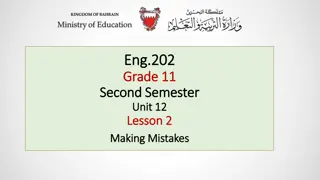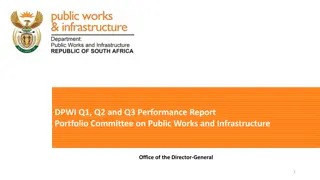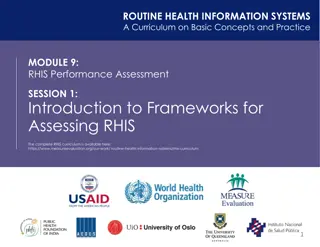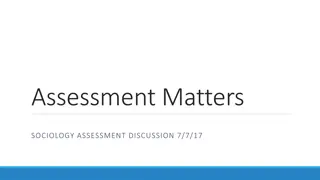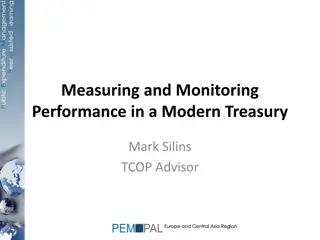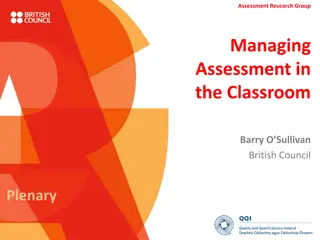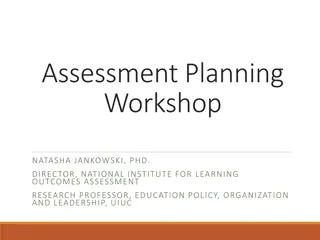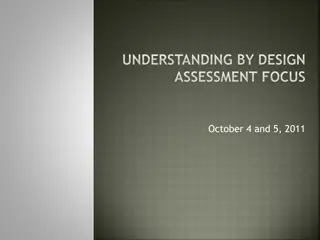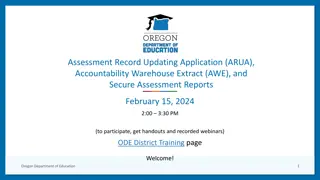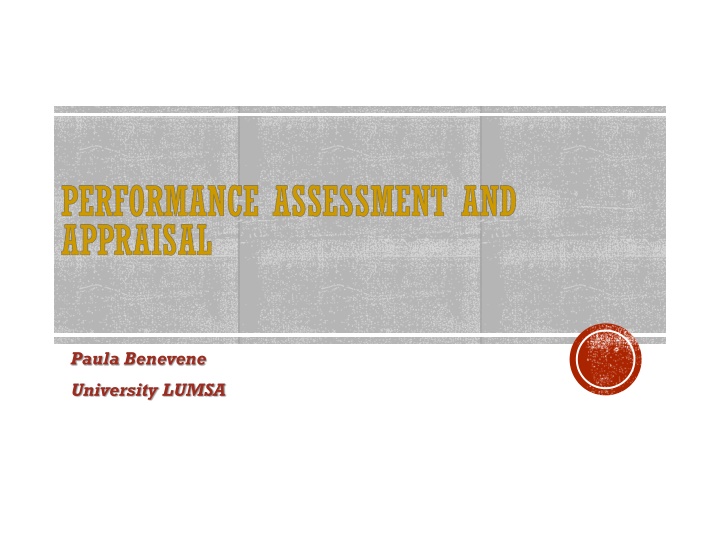
Effective Performance Appraisal Systems: Key Components and Objectives
Understand the significance of performance appraisal systems in evaluating employee work quality and results. Learn how these systems motivate staff, enhance communication, and bring recognition. Discover critical issues, development of evaluation criteria, and the importance of clear, measurable objectives.
Download Presentation

Please find below an Image/Link to download the presentation.
The content on the website is provided AS IS for your information and personal use only. It may not be sold, licensed, or shared on other websites without obtaining consent from the author. If you encounter any issues during the download, it is possible that the publisher has removed the file from their server.
You are allowed to download the files provided on this website for personal or commercial use, subject to the condition that they are used lawfully. All files are the property of their respective owners.
The content on the website is provided AS IS for your information and personal use only. It may not be sold, licensed, or shared on other websites without obtaining consent from the author.
E N D
Presentation Transcript
Paula Benevene University LUMSA
It means measuring and assessing the work done and the results achieved by an employee, analyzing both according to his/her requirement and on the basis of predefined objectives; The results achieved qualitative and quantitative; The skills, behaviors and knowledge put in place by the employee in achieving these objectives; The personality of a subject or his/her unexpressed potential is NOT evaluated.
A performance appraisal system can: Motivate staff to improve their work style; Promote recognition of merits; Improve communication between employees and management.
The evaluation system must operate in a fair, consistent and objective way to be motivating; Performance evaluation should be carried out at pre-established and regular time intervals (one year,six months); It should be part of an integrated system of rewards, planning of objectives and economic-managerial control; An effective performance appraisal system has standardized forms of appraisal, performance measures, feedback guidelines, and disciplinary procedures.
TWO CRITICAL ISSUES The development of indexes or evaluation criteria and the related evaluation measures; The feedback.
THE OBJECTIVES MUST BE: Defined in a clear,specific,concrete way; Observable and measurable through the detection of suitable behaviors; Consistent with the responsibilities,tasks and resources assigned to the employee; Scheduled over a period of time; Goals can refer to individual, group or corporate performance.
PREPARE AN EVALUATION FORM The form should focus only on areas essential to job performance, without covering in detail all aspects of an employee's performance; Limiting the areas of interest makes the assessment more meaningful and allows both the manager and the employee to address the problems of greater importance; Performance measures can also objectively measure certain work areas related to work habits. For example, you can establish an objective measure to define the acceptable number of times an employee can be late during a given period of time.
POSSIBLE AREAS TO CONSIDER IN A PERFORMANCE EVALUATION FORM: Professional knowledge and skills; The quality of the work done; The amount of work done; The amount of time it took to carry out your own work and meeting deadlines; Work habits and attitudes towards work. In each area, descriptors must be reported (for example: much lower than required, slightly lower than required; satisfies what is required; exceeds what is required;far exceeds what is required). The evaluator should be able to explain the reasons for his/her evaluation in the form.
PERFORMANCE APPRAISAL OF THOSE WHO OCCUPY POSITIONS OF RESPONSIBILITY OR COORDINATION SHOULD ALSO CONSIDER: The ability to motivate and provide guidance; The ability to communicate; The ability to create and manage a team; The ability to manage and solve problems. It is advisable to prepare a separate evaluation form for managers or add a specific section to the standard evaluation form.
Job performance is more difficult to measure when attitudes towards work are considered.In these cases, it is not necessary to describe the attitude, but rather to describe the employee's behavior (which derives from the attitude),and the consequences of this behavior in the working practice. For example: "The employee does not cooperate with his colleagues. When another member of his department is absent, he refuses to take on the additional duties necessary to treat patients in a timely manner. This behavior generates a work backlod, adds more work for the rest of the staff and compromises the effectiveness of teamwork."
DEVELOP WORK PERFORMANCE EVALUATION MEASURES Starting point: the job description, that it is the description of the duties and tasks related to the job position and role. Then, the key factors are selected to be specifically measured. It is then necessary to involve the employees concerned to integrate the key factors with quantitative data and information, also from a historical point of view, to identify the additional factors that contribute to achieving the expected results.
DEVELOP WORK PERFORMANCE EVALUATION MEASURES It is important to keep job descriptions and performance measures up-to-date, otherwise when an employee does not turn out to be up to the identified standards, we cannot know if this really depends on the person or if our expectations will be unrealistic or inadequate ( e.g. because the volume or quality of work required has increased, or if the conditions or context in which the employee operates have changed). If the organization is large and the positions to be evaluated are numerous,an ad hoc working group can be entrusted with the task of identifying the evaluation criteria and measures.
PERFORMANCE AND REMUNERATION At the time of hiring it must be communicated verbally and in writing to employees if the employment contract or in any case their job position provides for a salary revision following the performance evaluation; It is important that employees are informed on this point so that their expectations are realistic.
THE FEEDBACK Feedback is a key part of evaluation; The evaluators must be able to give and receive feedback, which must cover both the positive aspects and those to be improved; A common mistake is to overlook an employee's shortcomings or just focus on their strengths.
Indicate the areas where it is necessary to improve the worker s performance; Outline the expectations for improvement; Explain how you intend to help the employee respond positively to those expectations; Offer examples of desired behaviors, or suggestions, or training opportunities, useful for overcoming problematic aspects; Communicate to the employee acceptable and what will not be considered tolerable, and then establish a plan for subsequent employee performance monitoring and reassessment. what is deemed
After discussing the evaluation results with the employee, ask him to comment on the evaluation received and offer his feedback and invite him to offer his suggestions to improve the deficient behaviors; The goal of the feedback exchange is to create open communication between the assessor and the worker, facilitating the understanding of their respective points of view.
It has as its object the actions and behaviors of the employee,not his personality; It refers to specific goals; It is punctual,continuous and future-oriented; It has a clear and specific language; Avoid generic comments and judgments about the person; It is a two-way process.
Criticism has a positive impact if it helps people to improve, it has a negative impact if it tends to demoralize people; Positive feedback is useful if it gratifies people, it has a negative impact if it generates unmotivated expectation; If the feedback provided does not offer clear and specific evaluation elements it is difficult to understand and cannot improve future performance; If it is too general or generic, it risks being interpreted according to the employee's reference framework.
DISCIPLINARY PROCEDURES It may happen that an employee continues to perform poorly, even after a critical performance and a thorough discussion of expected improvements; evaluation of their To manage this situation it is necessary to have written and defined disciplinary procedures; The procedures should define the actions that will be taken if the problems persist or worsen:a verbal warning, a written warning, and the removal or termination of the employment relationship if the situation does not evolve positively.
VERBAL WARNING It must be communicated privately, clearly specifying the behavior or reason why the employee is recovering and the potential or actual consequences of his or her actions. After having verbally admonished the worker, explain to him/her what the consequences will be that s/he may face. In the end, give the worker the opportunity to reply, but do not open a debate on the question raised, rather limit yourself to a brief exchange.
WRITTEN WARNING It must include the following elements: A description of the behavior or problem generated and its consequences,both actual and possible; The actions and changes expected by the worker; Any support that the employer will offer to support the improvement of behavior; A description of what will happen (for example, the non- renewal of the contract,or a warning letter) and when (for example, after a certain event or at the second delay at work),if the notice is not heeded; The employee's signature and the date of the notice.




